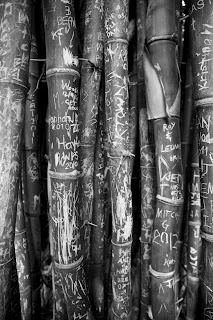As recommended by Freeman in Part Two of the course materials at page 71, it may be helpful to tackle this part of the course in black and white. The rationale is, that our attention is more focused on the graphic elements of the picture when the image is shot in or later transferred to black and white. As you can see with my exercise on single points, the greenstone is very vibrant, and the colour itself (although it serves as a point) a monochrome image would help the viewer to focus more on the graphic elements in the composition.
I never actually set out to photograph in black and white, but occassionally,as a post production strategy convert colour to grayscale. A well crafted black and white image tends to bring out the tones, contrasts, and is much more dramatic than a colour shot. Freeman(1), in http://thefreemanview.com/observations/when-black-and-white/(2) - gives a quick overview about when to use black and white. I think the main point too, is to shoot in colour and then convert to black and white otherwise the camera's processor will throw away valuable information that you could use to edit your image.
For example, I am working with Camera Raw and I alter the hues/saturation channels before converting to grayscale. At the moment I am merely experimenting with what looks good.
Some of my images which have appeared extremely dull (shot on a grey day) have been more effective once converted to black and white. I guess it is the sense of drama. I am not too certain though, that I have mastered the technique of getting the right blend of tones when I adjust my colours before converting to grayscale. I guess it a matter of personal preference but I need to do some online research into the various techniques for adjusting tones.
I converted this photograph of bamboo to black and white, and in doing so, the contrast of tones really stood out. The colour image was fine, but the verticle lines stand out more in black and white.
This is a photograph by Toshihiro Oshima which I accessed from http://www.digitalrev.com/article/toshihiro-oshima-virtuoso-of-visual/NTY4NA_A_A. (accessed on 8/9/12) His black and white work is amazing, full of drama and very soulful. This composition highlights the contrasting tones of the white kimono and the shadowy background.
(1) Freeman, Michael,(2007).The Photographer's Eye: Composition and Design for Better Digital Photos, The Ilex Press, page 126
(2)http://thefreemanview.com/observations/when-black-and-white/ (accessed 7/9/12)



No comments:
Post a Comment